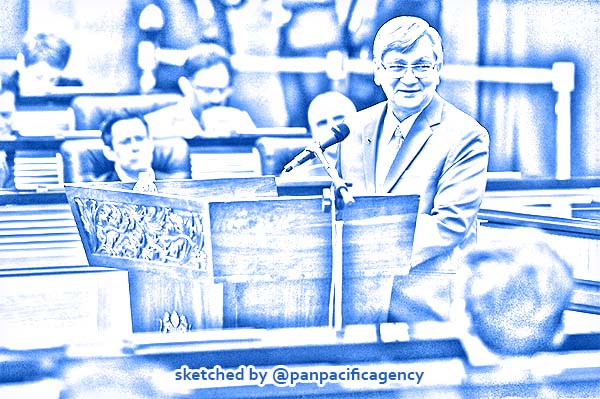Building a virtual parliament can take up to two years for Malaysia

At noon, Mohamad Ariff released a statement saying the application by Tun Dr Mahathir Mohamad to convene a special sitting this Monday had been rejected on grounds that it did not meet the prerequisites. — Picture by Miera Zulyana. Sketched by the Pan Pacific Agency.
KUALA LUMPUR, May 17, 2020, NST. Setting up an electronic parliamentary system can take up to two years and an investment of between RM2 million and RM5 million, and creating an e-voting system could cost around the same, New Straits Times reported.
Professional technologist Arief Affendi Ab Wahab said the estimate included the contractor’s fee and a study of the detailed system requirements.
“This covers diagnostics of the infrastructure, the specifications required, including the number of users involved, storage for recording, as well as security and data management,” he told the New Sunday Times.
However, the information technology expert said, this did not include site checks, updates and upgrades to the software manually or by cloud.
“If the current features meet the requirements, contractors can install basic open source or licensed systems in two to three-months. If more customisation is needed, then it can take eight to 12 months.”
The alternative to the virtual teleconferencing was to have the Parliament information technology team set up software such as Webex or Zoom, which could be done within days for a monthly subscription of below RM100.
Arief said if the e-voting component was installed with the main application, the cost could be reduced.
However, he said, the difference would not be much.
“Also, if it is installed as a separate system, it could take another six to eight months.”
He said some universities had developed e-voting systems at lower costs than commercial setups, but stressed that features used by commercial outfits determined the price.
“Some providers include end-to-end encryption, password protection and by-invitation features as security measures.”
On the drawbacks of using free or reasonably-priced systems such as Zoom following its recent data breach, Arief said everyone was exposed to some risk, even with licensed software.
“If there is any attack, open API (Application Programming Interface) and open source systems give no guarantee that they will resolve the issue immediately.
“On the other hand, proprietary licence software service providers and contractors are obligated to rectify and patch it immediately according to the Service Level Agreement.”
Network security expert Dr Zuriati Ahmad Zukarnain said the software used had to incorporate blockchain technology to secure the system’s data.
“The cryptographic authentication is used in cryptocurrencies such as Bitcoin, so it’s one of the safest data technologies to protect personal data.”
She said the technology allowed system owners to determine protocols for users such as password, facial recognition and other virtual protocols that were crucial, especially for e-voting.
“For the e-parliamentary sessions, you would not want someone else logging on with an MP’s identity and causing chaos,” said the professional technologist, who is deputy dean at Universiti Putra Malaysia’s School of Graduate Studies.
The overarching risk here is that confidential data such as health and banking details of MPs can be stolen; private data such as Internet consumption habits could also be laid bare. Leaks such as this have also exposed financial and sex scandals.
She, however, said that for e-voting the consequences of not using blockchain was more severe as administrators could manipulate the data they receive.
“As laws and budgets are passed in Dewan Rakyat, we can’t have claims of people voting when they did not, or having the system stating that they have voted in favour when, in fact, they objected to a motion.
“Here, blockchain technology can use transaction authorisation codes as how it is used in banks.
“Texts can also be sent to MPs’ handphones to notify them of the time, what or who they voted for. They can also call the system administrators if there is a breach or error.”
Damansara MP Tony Pua backed calls for an e-parliamentary system to, among others, promptly reinstate the session after its indefinite postponement to follow the Yang di-Pertuan Agong’s royal address tomorrow.
He said while a system could be installed on Tuesday, other matters that would need more time, included ironing out the operational training for the system, setting a notice period, as well as installing the system for MPs.
“But it is far from rocket science and doesn’t cost a lot of money.”
Pua said e-voting could also be done and Parliament only had to agree to the way the votes were to be recorded.
On concerns about leaks, he said the risk was there in any meeting and Parliament sessions were meant to be transparent.
Former Dewan Rakyat deputy speaker Datuk Seri Dr Wan Junaidi Tuanku Jaafar supported efforts to create an e-parliament, but stressed that it could take up to a year or more as the house rules had to be amended.
“First, the speaker must make an appeal to the king to allow for parliamentary sessions to be done outside the Parliament building.
“He also has to make a new decree to endorse this because when the building was built in 1959 and the king at the time had decreed that the house was henceforth where Parliament meetings would be held.”
He said this was because the Standing Orders of the House dictates that the Yang di-Pertuan Agong would decide when and where the Dewan Rakyat meetings would take place.
“There is the issue of rights and privileges of MPs. Do they continue to receive their meeting allowances as they are attending the sessions from their homes? More importantly, we need to find out if what is said in the meetings would be liable for lawsuits. All these need to be considered.”